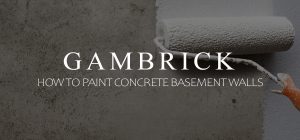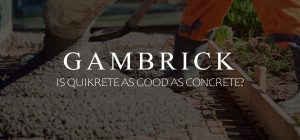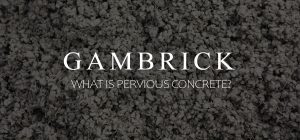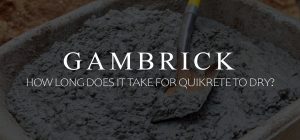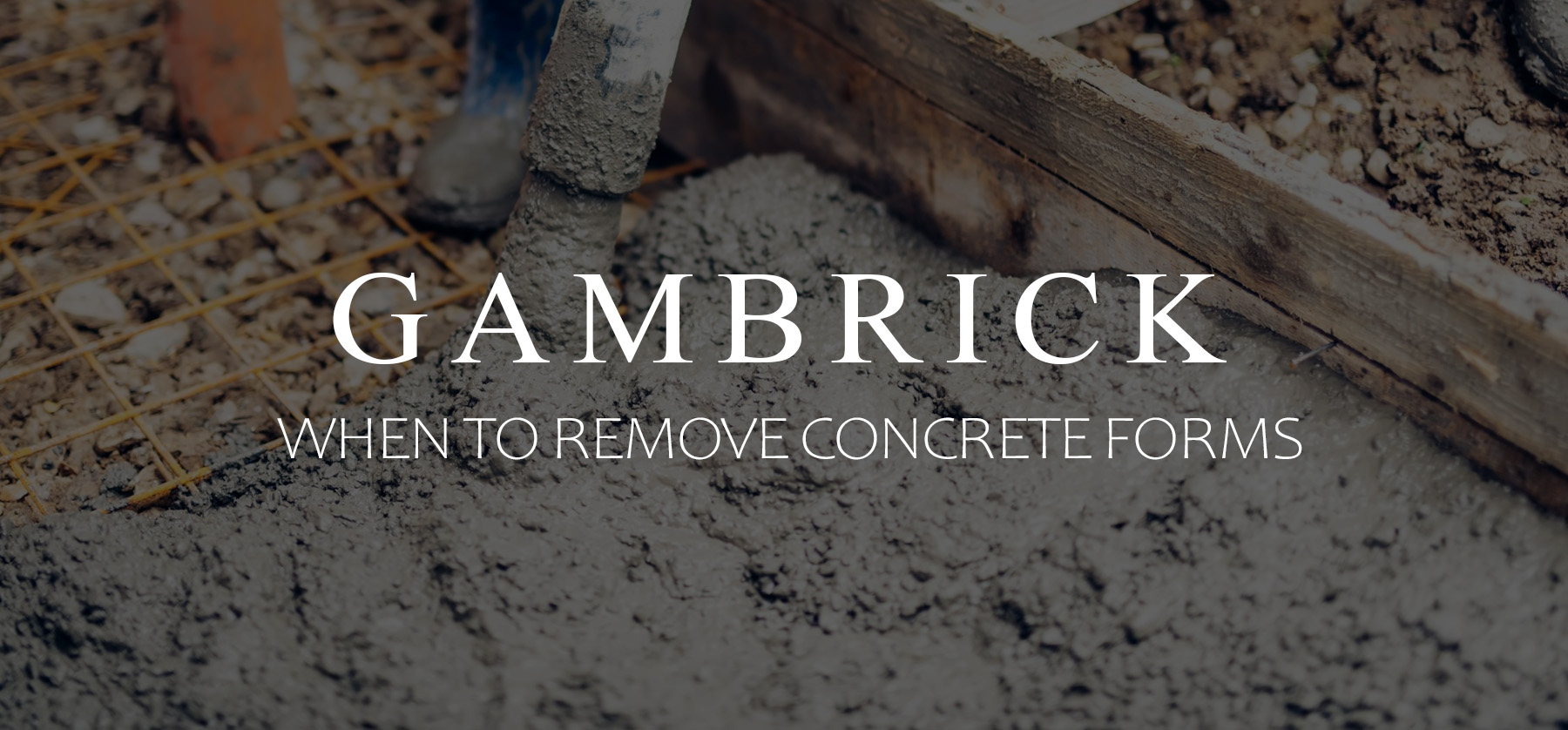
When To Remove Concrete Forms
Most concrete forms can be removed after 24-48 hours of curing. However, for some large structural builds, forms can stay on for over a week. Large pours take longer to cure and harden. For finished cast products like concrete countertops, forms can be removed after just a few hours. If you wait too long, the concrete will get too hard to smooth.
I’ve been a mason for over 25 years and can tell you firsthand that the right time to remove your forms depends on how you plan on finishing the concrete. If you’re building a foundation, wait a few days to a week until the concrete is extremely strong. However, if you plan on smoothing the surface, such as with a patio edge, or concrete countertops, remove the forms after the concrete has set but before it fully hardens.
When I make board formed concrete, I wait a few days to remove the forms. As the concrete hardens it retains the natural wood grain of the planks used to build the forms.
Concrete is poured wet but then hardens to retain the shape of any form or mold it’s poured into. Because of this characteristic, you can build almost anything out of concrete. This includes, foundations, footings, walls, statues, stamped concrete patios, countertops, planters, steps, driveways, etc.
To make concrete structures and products that last, concrete must be properly mixed, poured and cured in strong and durable forms. The forms must be built strong enough to contain the weight of the concrete. and they have to stay on long enough for the concrete to harden and cure.
Remove the forms too soon, and the structure or finished product can be ruined. Remove them too late, and the concrete will get too hard to properly finish.
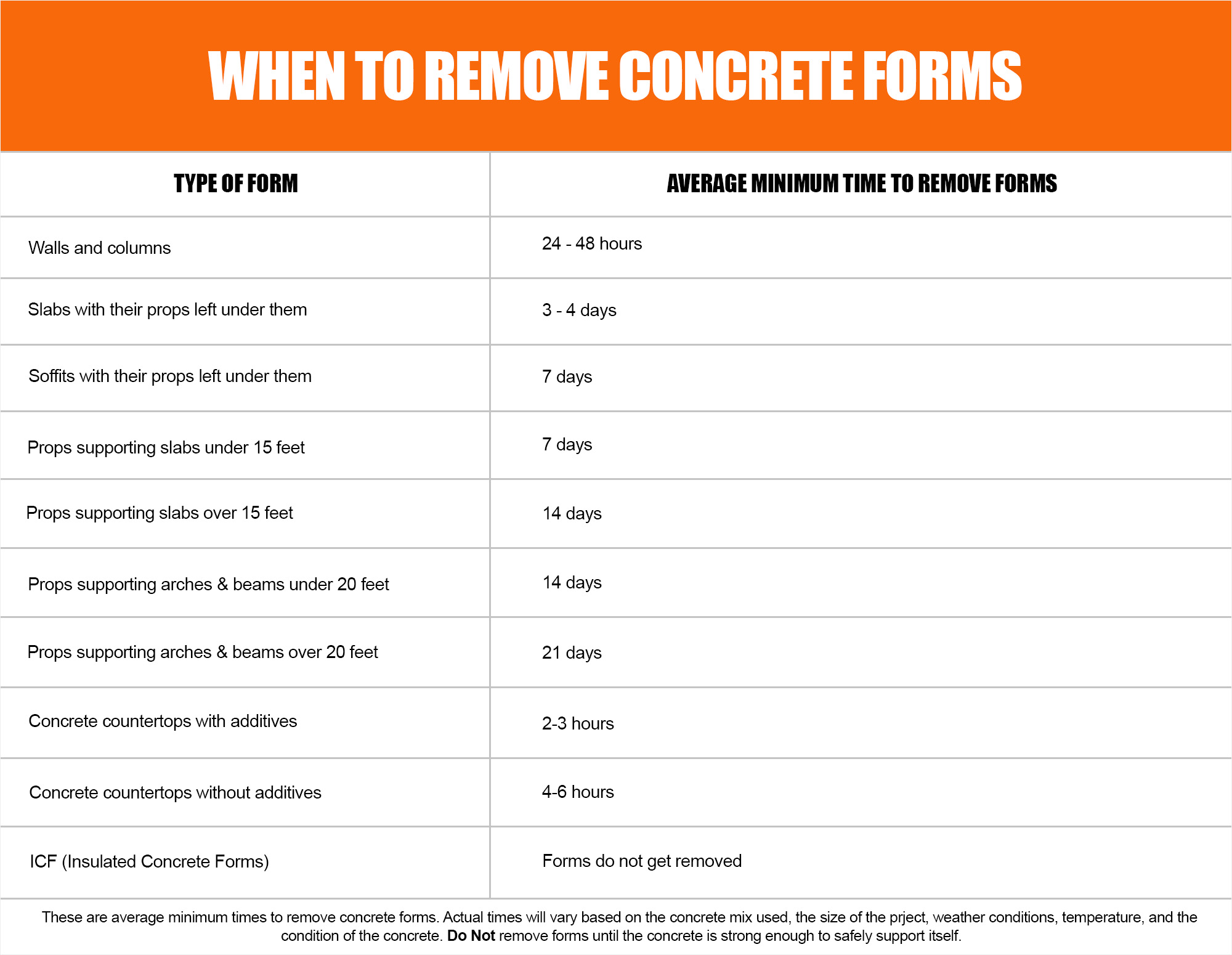
What Are Concrete Forms?
Concrete forms, also referred to as form-work, are anything built to contain and shape wet concrete. Forms are the container you pour wet concrete into. They can be large panels used to shape solid concrete walls or simply 2x4s that shape a sidewalk.
Forms can also be molds that are used to make concrete statues or cast products.
Footings are typically formed out of 2x lumber or plywood. Concrete countertops use forms made from melamine or plastic.
Concrete retains not only the shape but also the texture of the form it’s poured into. This can be both a benefit and a disadvantage. If you want a smooth finished product, like a countertop or statue, the forms have to be perfectly smooth. Any small imperfection will show in the finished product.
However, if the concrete won’t be seen, for example if you’re poring a concrete footing or retaining wall, you can use rough plywood or panels.
You can take advantage of concrete’s malleability by using forms that have a texture you want to transfer to the finished concrete. Board formed concrete is a great example. Individual wood planks are used to form concrete walls instead of panels because the concrete retains the look and texture of the boards. It’s a very beautiful, modern look.
When the concrete is hardened, the forms can be removed and a solid mass is unveiled in the shape of the inner face of the form.
Knowing when to remove concrete forms is a very important part of concrete work.
When Should Concrete Forms Be Removed?
Forms should not be removed until the concrete gains enough strength to support it’s own weight. Reference the chart above.
Concrete is poured wet. The forms are there to support the concrete while it hardens. As concrete dries it also grows stronger. This is called curing. Eventually, the concrete gains enough strength to support itself without the forms. The forms should not be removed until this occurs.
There are a few factors that can effect how fast the concrete strengthens which effects when you can remove the forms.
- Concrete Grade: Better grades of concrete harden and grow stronger faster. Commercial concrete we buy here in the United States is high quality and reliable. It typically cures and strengthen at a reliable speed. But this is not the case in most other countries that produce concrete out of naturally sourced materials.
- Cement Grade: The higher grade cement you use the faster the concrete will cure and the stronger it will become.
- Cement Type: The type of cement used to make the concrete effects its strength and cure time. For example, rapid setting cement cures faster then standard Portland.
- Temperature: At very low temperatures, concrete takes longer to cure and harden. In extremely hot temperature, concrete can dry too quickly which makes it weaker. The best time to pour concrete is in medium heat.
- Size: When concrete cures it produces heat. The more concrete you pour, the hotter it gets. This effects cure and dry times.
- Additives: Chemicals can be added to the concrete mix to make it harden faster.
If the concrete doesn’t need finishing you can leave the forms on much longer. However, if the concrete needs finishing, such as with concrete countertops, the forms must be removed before the concrete is fully hardened.
What Happens If Concrete Forms Are Removed Too Soon?
If you remove forms before the concrete has had time to strengthen enough to support it’s own weight the structure can experience damage. This can be dangerous if the concrete is structural and eventually needs to bear weight.
Here are a few of the most common problems you’ll encounter if you remove the forms too soon.
- Cracks: Concrete is more prone to cracks during curing then when it’s fully hardened. If the forms are removed too soon before the concrete is hard, pressure can cause cracks to open up. These cracks can be wide and deep which may result in structural weakness. If small cracks occur, fill them with a crack filler to prevent future damage. If large cracks open up, repair them with fresh concrete or epoxy.
- Slumping: Before concrete is hard it’s still a semi-solid. Without forms to support the concrete structures weight, semi-solid concrete can start to bulge or fall to one side. This is called slumping. This is more common the larger and heavier the concrete structure is.
- Collapse: If forms are removed too soon you risk a total collapse of the structure. The faster you remove the forms, the more likely a collapse will occur. This gets more likely the larger and heavier the concrete structure is.
Weather conditions effect when you can safely remove concrete forms. Remember, concrete cures faster in hot weather and slower in the cold. It also cures faster in dry weather than in wet conditions.
Why Do The Forms Have To Stay On So Long?
Concrete is a unique material because it grows stronger as it dries and hardens.
The strength rating of concrete is measured in PSI or Pounds Per Square Inch. This is a number that measures it’s compressive strength which is concrete ability to bear heavy loads without breaking. The higher the PSI, the more weight the concrete can safely support.
When you look at a bag of Quikrete that says 3500 concrete. It means 3500 PSI. But what it really means is 3500 PSI after 28 days of proper curing. When 3500 PSI concrete is freshly poured it’s not anywhere near 3500 PSI.
After a day or so of drying, 3500 PSI concrete may only be around 700 PSI. That may be strong enough to walk on, but it’s not strong enough to support tons of concrete poured 10 feet high. The larger and heavier the concrete pour, the stringer the concrete needs to be before you can remove the forms. Remember, the forms are what’s supporting the weight of the concrete. You can;t remove them until the concrete can support itself.
For small concrete jobs, like a 4″ sidewalk, you can usually remove the forms in a day or two. However, for large scale construction projects, like foundation walls, the forms can stay on for over a week.
When you can remove the forms is all about the concrete’s strength and the type of project you’re building. The larger and heavier the pour, the stronger the concrete needs to be before you can safely remove the forms.
How To Properly Remove Concrete Forms
When it comes time to remove the concrete forms you have to do it properly. Small forms used to build a sidewalk or countertop are safe and easy to remove. But the large panels used to build solid concrete walls can be dangerous. They’re heavy and may need special equipment to move around the jobsite.
Before you remove the forms supporting a large concrete structure, consider running an NDT (Non Destructive Test). An NDT can determine the compressive strength of the concrete without damaging it.
Once you determine the concrete is strong enough to support itself without the help of forms you can start removing them. If you have any doubts about the concrete’s strength, I’d get it tested or let it cure a bit longer.
A safety engineer should inspect the site before you remove the forms to make sure conditions are safe.
Small concrete forms used to build things like steps, countertops, sidewalks and driveways can be taken away much easier. In these cases, removal isn’t generally a safety issue.
When removing small forms, I usually start with the supports. For example, when forming a sidewalk, I screw 2x4s or 2x6s together and then reinforce behind them with stakes. When it comes time to remove the forms, I start with the stakes. Then I start pulling off the 2x lumber.
I always remove forms in reverse order from how they were built.
Can Weather Conditions Affect Form Removal?
Weather has an influence on when you can safely remove concrete forms because it effects how concrete dries and cures.
When concrete gets extremely cold, curing slows down and the concrete can even freeze. In freezing temperatures, curing blankets are used to increase the concrete’s temperature. It’s very important to keep concrete above freezing. If the concrete freezes it will not cure and could deteriorate.
As a general rule, I always keep my forms on longer in cold weather because curing is slower.
Extreme heat can make concrete dry out and harden too fast. In this case, moisture should be spread on top of the concrete or plastic sheeting can be used to control evaporation. If the concrete dries too fast, it can become brittle and cracked around the edges. You have to be extra careful when removing the forms.
The hotter the temperature, the faster concrete dries and cures. But I still recommend keeping the forms on for the entire recommended time period just to be safe. There’s no need to rush.
Rain is a problem for drying concrete in the first 1-2 days. After that, the concrete will be hard enough on the surface so that rain doesn’t effect it.
Moisture in the air can effect concrete dry time. In really hot weather, concrete will dry faster than when it’s wet outside.
As a general rule, I always keep the forms on for at least the recommended time-frame. In some cases I’ll remove them later than expected but never sooner.
Whenever possible, I remove the forms in good weather. Large scale forms can be dangerous to remove so I don’t want the additional issues of ice, rain, extreme heat or snow effecting the process.
What If My Concrete Pour Is Large?
The size of the concrete pour can effect it’s cure and dry time. But it depends what you mean by a large pour.
If you pour 20 yards of concrete for a large driveway or patio that’s only 4-6 inches thick, the cure time shouldn’t be effected. Even though you’re pouring a lot of concrete, it’s spread out over a large area and not thick.
However, if you pour a single 20 yard concrete pier on a large scale building project, cure times will be effected. When you pour a lot of concrete in a relatively small area, like a bridge or roadway pier, it produces a lot of heat as it cures. Builders monitor the concrete’s heat using heat guns to make sure the concrete doesn’t get too hot.
Where your concrete is poured can effect form removal too. If it’s a footing that’s supported by Earth the forms can be removed faster than when the concrete is suspended.
When in doubt, I usually keep the forms on a little longer just to be safe. Unless there some reason why the forms have to come off, for example if you’re finishing the sides, I leave them on for as long as possible. Every day the concrete grows stringer it makes form removal a little bit safer.
How Long Does It Take Concrete To Dry?
Concrete should be dry and hard enough to walk on after 24-48 hours. However, just because it’s hard enough to walk on doesn’t mean it’s strong enough to remove the forms. Concrete has to be string enough to support itself before you can safely remove the forms.
For large pours, like a foundation wall, there can be tons of concrete poured over 10 feet high. It can take over a week for the concrete to cure strong enough to support that much pressure even though the surface is dry. However, if the pour is a 4 inch sidewalk, the forms can sometimes be removed the next day.
Don’t confuse surface drying with curing. The surface of the concrete always dries first and fast. The center of the slab hardens much slower. Even though the surface may appear totally dry, the inside may still be soft and relatively weak.
It normally takes about 28 days for concrete to be completely cured.
Can I Leave Concrete Forms In Place?
Concrete forms can be left in place but it’s usually not a good idea. They can get in the way of further construction, don’t look great and can rot.
If you want to leave the forms in place after the concrete is cured, make sure the materials you build the forms out of won’t rot. Most types of wood will rot when left outdoors.
Some forms, like ICF ( Insulated Concrete Forms) are designed to be left on the concrete. The forms are made of rigid foam insulation and provide additional R-value to the concrete. They’re made from a type of foam that’s resistant to the elements.
Almost all builders reuse the larger concrete forms again and again so they have to be removed after the job. However, for smaller jobs, like forming a small sidewalk, the forms don’t have to be reused. In many cases we use scrap wood to make the forms.
In the case of concrete countertops, plastic forms are used to shape the counters. After the counters dry, part of the form snaps off and part stays behind.
In some cases we use composite materials like Azek to build concrete forms. After the slab dries, we leave the Azek in place. It’s weather resistant, doesn’t rot and creates a nice white edge for the concrete.
In the majority of cases, the forms are removed after the concrete cures. Most of the time there’s no reason to leave them behind. They usually look ugly and get in the way of construction. However, in some rare cases they can stay.
How Long Should Quikrete Cure Before Removing Forms?
When your working with Quikrete, how long you should wait to remove the forms depends on what you’re building and what type of concrete mix you use. Quikrete offers a variety of strengths and specialty mixes that set faster than normal.
If you’re pouring a thin slab of 4-6 inches, the standard Quikrete mix should cure at least 24-48 hours before you remove the forms. But just like with regular concrete, large Quikrete pours that are heavy or tall require the forms to stay on much longer because they’re heavier.
Quikrete fast setting mix hardens faster than the standard mix. In some cases, you can remove the forms in just a few hours.
No matter what type of Quikrete you use, don’t remove the forms until the concrete is strong enough to support it’s own weight. If you remove the forms too soon, the structure could collapse.
If you’re using a regular Quikrete mix, the amount of time forms should stay on is the same as regular concrete.
When To Remove Concrete Forms To Finish Countertop Sides?
When I pour concrete countertops, I use a fast setting mixture or add chemical hardeners to a standard mix. This allows me to remove the forms after just an hour or two. It’s important to remove the forms before the concrete is fully hardened so that you can smooth the sides.
If you’re using a standard concrete mix without additives to make your countertops, you’ll have to wait at least 4-6 hours before removing the forms.
Be careful when you remove the forms. But since the concrete is still workable, if you see cracks or imperfections you’ll be able to fix them.
Can You Leave Concrete Forms On Too Long?
Whether or not you can leave concrete forms on too long depends on what you’re building.
If you’re pouring footings, building a concrete wall or a set of steps, there’s no negative impact to leaving the forms on for long periods of time. This is true of most concrete structures.
However, if you’re pouring concrete countertops that need finished sides, you can leave the forms on too long. If the concrete gets too hard to finish, you won’t be able to smooth or repair the sides of the counters.
Whenever you have to smooth or finish the concrete sides that touch the forms, you can leave them on too long. In these cases, the forms have to come off while the concrete is still workable.
Do You Have To Remove Concrete Forms?
In most cases you don’t have to remove the concrete forms if you don’t want to. However, they usually don’t serve a purpose after the concrete is fully cured and can get in the way of future construction.
If you plan on leaving the forms on, make sure they’re made of a material that won’t rot.
When pouring concrete countertops with plastic forms, typically the sides of the forms snap off while the underside stays in place. So in this case only half the form is removed.
A concrete form that’s designed to stay in place after the concrete cures is called ICF (Insulated Concrete Forms). They’re specially made concrete forms made from rigid foam insulation that stay on the walls after the concrete has cured. They provide R-value to the home, don’t rot and can be finished with other materials to enhance their appearance.
Concrete pools are another type of structure that can be built out of ICF forms. The forms stay in place after the concrete has cured to insulate the pool water.
In most cases, you don’t have to remove the forms if you don’t want to. However, there’s no reason why most forms should stay on after the concrete has cured. And most forms are expensive and reusable so you’ll want to remove and reuse them again and again.
Summery: When To Remove Concrete Forms
Most concrete forms can be removed after 24-48 hours of curing. However, for some large structural builds, forms can stay on for over a week. Large pours take longer to cure and harden. For finished cast products like concrete countertops, forms can be removed after just a few hours. If you wait too long, the concrete will get too hard to smooth.
I’ve been a mason for over 25 years and can tell you firsthand that the right time to remove your forms depends on how you plan on finishing the concrete. If you’re building a foundation, wait a few days to a week until the concrete is extremely strong and hard. However, if you plan on smoothing the surface, such as with a patio edge, or concrete countertops, remove the forms after the concrete has set but before it fully hardens.
When I make board formed concrete, I wait a few days to remove the forms. As the concrete hardens it will retain the wood grain of the planks used to build the forms.
Concrete is poured wet, hardens and retains the shape of any form it’s poured into. Because of this characteristic, you can build almost anything out of concrete. This includes, foundations, footings, walls, statues, countertops, planters, steps, driveways, etc.
To make concrete structures and products that last, concrete has to be properly mixed, poured and cured in strong and durable forms. The forms must be built strong enough to contain the weight of the concrete, and must stay on long enough for the concrete to harden and cure.
Remove forms too soon, and the structure or finished product can be ruined. Remove them too late, and the concrete will get too hard to properly finish.
If you have any questions email or leave a comment below.

John Mazzuca | About | More Posts |
Custom Home Builder
John Mazzuca is a custom home designer and builder at Gambrick with over 25 years experience in the construction industry. John has designed, built and/or remodeled hundreds of homes, small buildings, and commercial projects. He writes about business, real estate, home building, and household electronics. His work has been featured in Fox Business, Better Homes & Garden, House Beautiful, and more.


